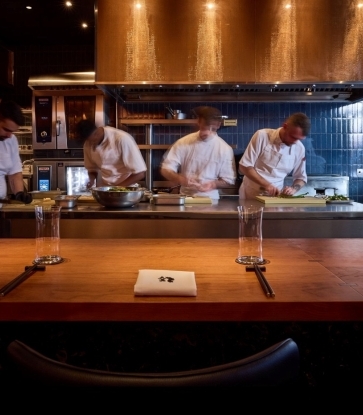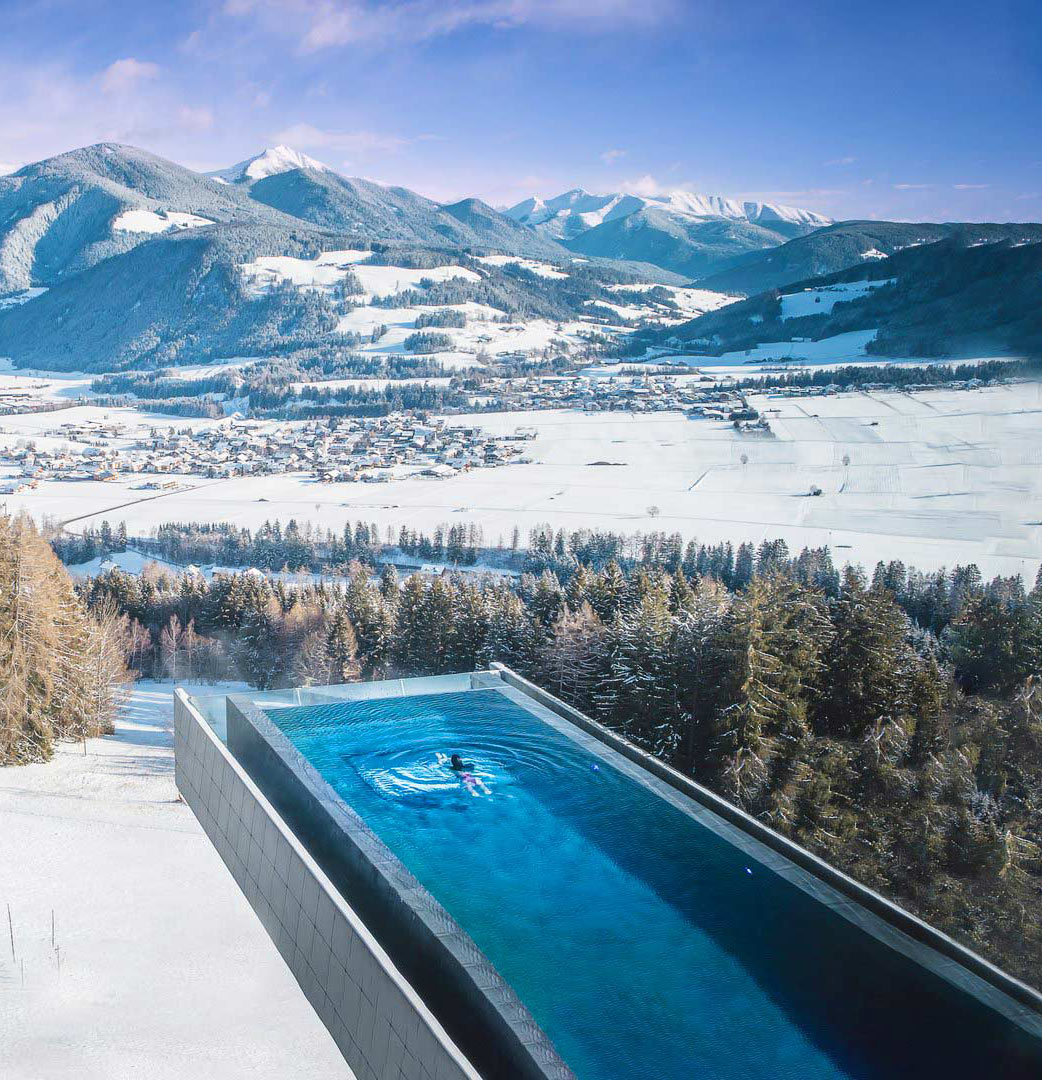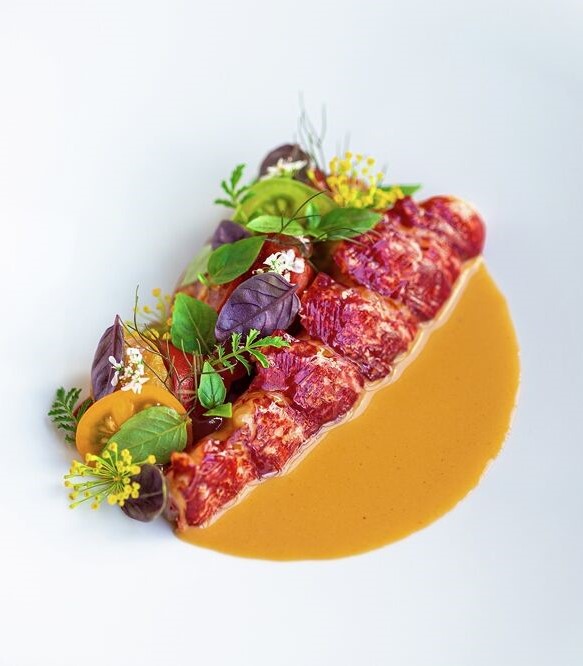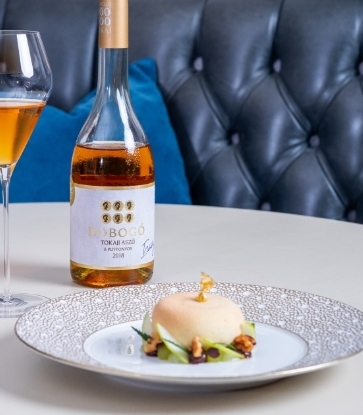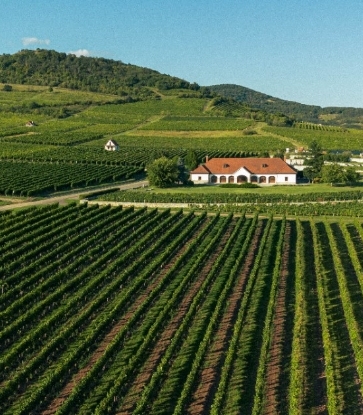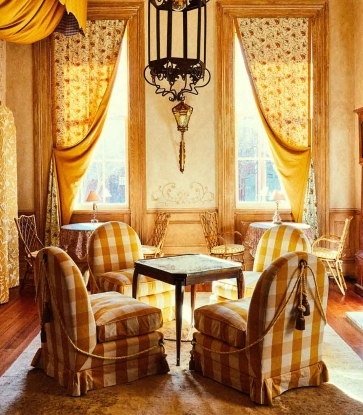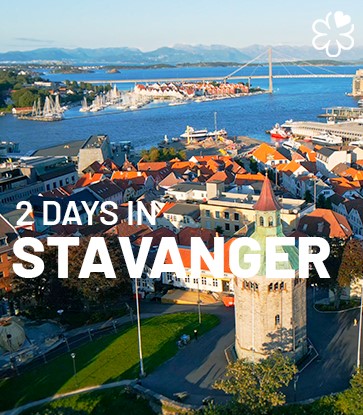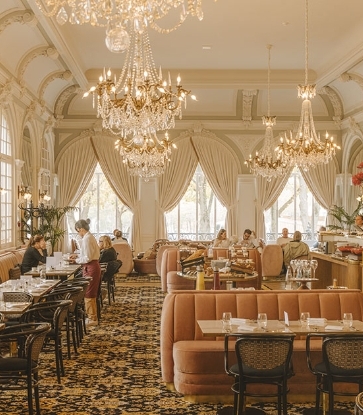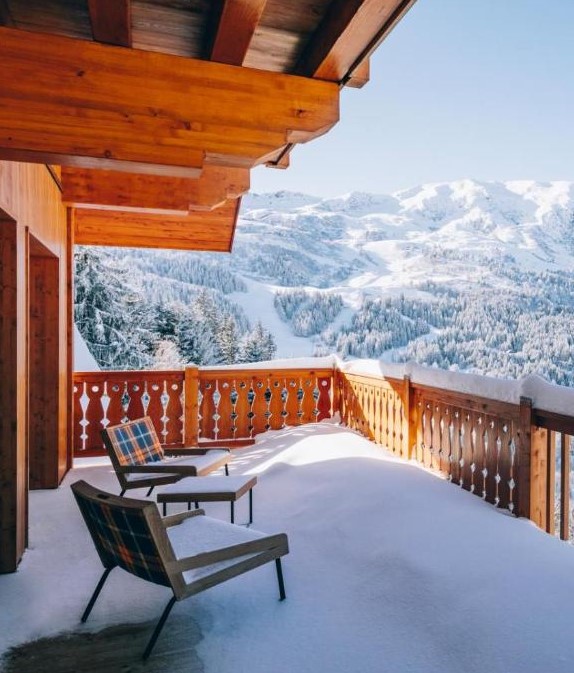The Argentinian capital stands along the banks of the immense Río de la Plata. It is a city renowned for its elegant architecture and cobbled streets, its theatrical and musical traditions, its legendary nightlife and innovative gastronomy by creative chefs who source ingredients daily from every corner of the country – from the jungles in the northwest to Patagonian valleys in the south, from the altiplano to vineyards backed by the Andes mountains, and from the stunningly beautiful Atlantic coast to the extensive plains of the Pampas, home to Argentina’s best meats. In this selection from The MICHELIN Guide, we are delighted to recommend a two-day exploration of Buenos Aires with a focus on the city’s best hotels and restaurants.
Day 1: The City’s Historical Centre
Morning
Coffee in Buenos Aires is much more than just a drink – it is part of the city’s culture and history and is a key aspect of its literature and daily life. Every morning, locals flock to traditional “cafetines” to order a “cortado” or a “café con leche” and a croissant: some prefer a sweet croissant made with pure butter, others a savoury option. Among hundreds of places to choose from, the Florida Garden is an institution which has been in business for over sixty years and has long been frequented by artists and intellectuals, politicians, businessmen and women, and sports stars, with names ranging from Maradona and Jorge Luis Borges among its list of famous customers.From here, it is possible to explore a large section of the city’s financial, historical and political district: the Avenida Corrientes with its large theatres and classic pizzerias (if you’re hungry, try a portion of fugazetta at the counter), the Casa Rosada and the Plaza de Mayo, and the Avenida de Mayo with its emblematic buildings such as the imposing Palacio Barolo, the architecture of which is a homage to the Divine Comedy, the iconic work by the Italian poet Dante Alighieri.
A few blocks from here, you’ll come to San Telmo, a district where tango is in evidence on almost every street corner. At the intersection of Bolivar and Carlos Calvo streets, you’ll find one of the oldest public markets in the city, the Mercado de San Telmo, frequented by locals and tourists alike. Here, you can buy fruit and vegetables and top-quality meat, as well as have lunch in one of the many street food kiosks inside. Choose between delicious “choripán” sandwiches, traditional meat empanadas, or a warming lentil stew, which is perfect on a cold winter’s day.

Lunch
The past and present come together in San Telmo, the historical quarter of the city home to antique shops and tenement buildings from the 19th century, as well as contemporary fashion designers and street artists (especially around Plaza Dorrego), including tango performers, poets, and an array of musicians. In addition to the Mercado de San Telmo, a good choice for lunch is to head for the Caseros boulevard, in particular the Caseros Bib Gourmand restaurant, where the honest, locally inspired home-style cooking on offer in its bright, fun and retro-style dining room includes dishes such as grilled langoustine and squid with sweet red peppers, and the “matambrito” of pork with potatoes and a rocket and fennel salad. A glass of Malbec is always a good option to go with your meal, preceded perhaps by the local vermouth as an apéritif.After lunch, why not take a stroll along this beautiful boulevard, which has become a gastronomic destination in its own right thanks to the plethora of dining choices on offer, ranging from vegan and vegetarian to Italian (including homemade pasta), as well as cocktail bars and pastry shops.
Evening
Follow the same route as the morning, but in the opposite direction, crossing the Avenida de Mayo once more and heading to the neighboring districts of Retiro and Recoleta. Many people refer to this part of the city as the Paris of South America, thanks to its aristocratic architecture that dates back to the arrival of immigrants from France during the 19th century. Here, impressive palaces, art galleries, historical monuments, and cultural spaces such as the National Fine Arts Museum and the National Library are well worth a visit. Along Avenida Alvear you’ll find the boutiques of leading international brands as well as many of the city’s luxury hotels. Head to the Palacio Duhau Park Hyatt Buenos Aires, built in 1934 by the French architect León Dourge, and take a seat on its terrace with views of the expansive gardens here.While you’re in this area, why not enjoy, especially as the sun is setting, a tasting of the different cheeses that are matured in a specially air-conditioned cellar, accompanied by a glass of wine from a choice of hundreds of labels from around the country. If you prefer, stroll through the gardens and take a seat at Gioia Cocina Botánica, the hotel’s “plant-based” dining space, where, in the afternoon, they offer snacks such as fried corn tortillas with a tofu and merken emulsion, bean ragu, creole salsa and sour cream; or the citrus tart with a vegan cheese frosting and citrus fruit.
If you still have plenty of energy when you leave the hotel, take a tour through the aristocratic Cementerio de la Recoleta, with its imposing mausoleums and vaults where many of the leading figures in Argentinian history have been laid to rest. If you prefer, head to the Ateneo Grand Splendid, a stunning bookstore considered to be the largest in South America. Opened in 2000, it occupies a splendid early-20th-century theatre with its original railings and a cupola adorned with 20-meter-diameter frescoes.
Next, cross the wide Avenida 9 de Julio, with its obelisk that's visible from a considerable distance away. Head along Calle Arroyo to visit some of the many art galleries here, some specializing in traditional works of art and others that are more contemporary. Enjoy a specialty coffee at The Shelter Coffee, then walk a little further to sample a glass of wine at the small bar of the Pro.vin.cia vinoteca. If you’re keen to taste some of the city’s famous cakes, continue to Dos Escudos, a traditional bakery that is a favorite with many of the city’s best chefs, where you’ll find an array of sweet and savory specialties such as “churrinches”, “fosforitos”, “sándwiches de miga” and “bizcochitos de grasa”.

Dinner and beyond
It won’t be easy choosing just one place to have dinner, as several of the best restaurants in Buenos Aires are located in this district. If your preference is for a smaller, attractive space serving contemporary cuisine based around French, Spanish and Argentinian traditions, why not head to Roux, run by Chef Martin Rebaudino. Here, you can savor colorful dishes that are high on detail, with a strong focus on flavor and the ingredients used. Options include warm oysters with golden apple purée, mussels and kiwi “tears”; carpaccio of roasted yellow beetroot with shavings of Serrano ham, kimchi, lemon gel and caramelized tomatoes; and its famous Segovian suckling pig with chimichurri.Another possibility is booking a table at Aramburu, the only restaurant in Argentina that has been awarded Two Michelin Stars, where the precise 18 course tasting menu is created with great artistry by Gonzalo Aramburu in a kitchen that is like a film set. Every plate is a miniature work of art, both in terms of its aesthetic appearance and its technical mastery. Examples include the pork with saffron served in passion fruit, the crunchy Mendoza-style vine leaves, and the “bombón” of pomelo served to resemble the center of a colorful sunflower.
A third option nearby is Marti, a restaurant run by Germán Martitegui, one of the best-known chefs in Argentina, where the cooking is based around vegetables. For many years, Germán was the face of creative fine dining in the country, receiving numerous plaudits from food critics and guests alike. In the past few years, he has also become a popular personality as a judge on MasterChef. At Marti, you can eat simple, yet tasty cuisine with ingredients sourced from small-scale producers across Argentina (we recommend the shawarma of mushrooms and grilled salsify) while sitting at the relaxed dining counter around the kitchen, with wine pairings chosen by the sommelier.
To continue your soirée, perhaps make for the Four Seasons Hotel Buenos Aires, located on the boundary between the Retiro and Recoleta districts, a strategic location for a hotel with a strong gastronomic identity. In addition to its relaxing spa and outdoor swimming pool, situated in the hotel gardens, the Four Seasons also offers several dining options. Elena is its main restaurant, serving dishes for sharing placed at the center of the table, especially meats that they mature themselves (such as the 45-day-aged Angus T-Bone), as well as fish, octopus, duck, vegetables, and much more. To keep in the party mood, the best place in the hotel is Pony Line, its contemporary cocktail bar. Why not try the “El otro vinito” cocktail, a mix of tequila, Sauvignon Blanc and “dulce de cayote”, which is both refreshing and delicious. If you’re keen to continue the cocktail theme, just a short distance away you’ll find Florería Atlántico and Presidente, two renowned bars that stay open until the early hours.
Day 2: Palermo, Villa Crespo, and Chacarita
Morning
Palermo enjoyed a renaissance as a young, resurgent district in the late 1990s and one that gained popularity with designers, artists and emerging chefs, making it the main gastronomic hub of the city at the time. Today, several neighboring districts (Chacarita, Villa Crespo, and Colegiales) demonstrate the same culinary appeal of Palermo through new dining options while maintaining the peaceful ambience of their tree-lined streets.Start your day, perhaps, in Palermo, with a flat white at Cuervo, a café that has become a legendary name among the specialty coffee shops in Buenos Aires. The coffee here is made from beans from different countries that are roasted on the premises, and can be accompanied by various food options, ranging from the delicious “alfajor” of almonds and “dulce de leche” to a lighter multigrain sandwich with avocado, sun-dried tomatoes, and rocket.
From here, explore this district with its numerous boutiques selling clothes and shoes by independent designers, unique lamps and pop décor, as well as small bookstores and verdant plant nurseries. Why not visit The Paul Gallery, a hidden gem where you can purchase elegant porcelain crockery amid a décor of native plants and colorful flowers. Much of the charm of Palermo can be found in exploring these streets, pausing occasionally in a bar or café such as Juan Pedro Chuntaro Style to order a freshly fried churro with dulce de leche before continuing on your way.
Lunch
If you’re keen to sample the best Argentinian meat, make sure you head to Don Julio, the city’s most legendary steakhouse. Awarded One Michelin Star as well as a Green Star, Don Julio boasts some of the best meat in the entire country (from British breeds reared on the pastures of the Argentinian pampas) which is always delicious, tender, and cooked to perfection. Start your meal with sweetbreads, the house specialty, and the charcuterie prepared by Chef Guido Tassi. Follow this with the rib-eye or skirt steak, and make sure you ask for a side of triple-cooked fries. The seasonal vegetables served here are also an absolute must, all of which are grown on organic farms that work exclusively with the restaurant. If you have time, visit the underground wine cellar, home to a unique collection of wines, including vintage labels from every corner of Argentina.You could also choose another of Buenos Aires’ culinary traditions, that of Italian cuisine, which developed during the major waves of immigration to the country between 1870 and 1920, when more than three million Italians settled in Argentina. Chef Julieta Oriolo is the daughter of Italian immigrants, and at La Alacena Trattoria (which has been awarded a Bib Gourmand), she prepares homemade pasta with durum wheat and free-range eggs and makes full use of fresh ingredients sourced daily from the market. In this friendly and relaxed atmosphere, you can order tempting and mouthwatering dishes such as mortadella tortelli with a velouté of fresh peas, and tagliolini with pesto, pistachios, and salted ricotta.

Afternoon
After lunch, it’s time to decide where to head next, perhaps to the more aristocratic section of Palermo with time to relax in the inner garden of the Casa Cavia, a stunning mansion built over a century ago and which has been reconverted into a complex featuring a restaurant, bar, café, florist’s, and a publishing house. The cuisine here, which includes breakfast, lunch, afternoon snacks and dinner, is under the baton of Julieta Caruso, who spent nine years working at Mugaritz, the legendary restaurant in the Basque Country, where she reached the position of Head Chef. Continue your exploration with a stroll through Palermo’s tree-shaded parks, where ducks glide across myriad lakes and locals explore by bike or on rollerblades, or simply sit quietly in the shade of jacaranda trees. You might like to end your walk with an ice cream in one of the many gelaterias in this district – Antiche Tentazioni is considered one of the best in the city.Another possibility is to explore Chacarita and Villa Crespo, two residential districts close to Palermo, which have been chosen by young up-and-coming chefs as the backdrop for their highly personalized style of cuisine. In Chacarita, it’s well worth heading to Santi Cheese, the cheese cellar owned by Santiago Valenti, to sample some of his cheeses made from sheep, goat, and cow’s milk that he matures until they are perfectly ready to eat. Or take a seat and enjoy an apéritif at Anchoíta Cava, an offshoot of the Anchoíta restaurant (awarded a Green Star), which serves over fifty varieties of cheese, as well its own charcuterie and dozens of different wines by the glass. In Villa Crespo, make sure you stop at the La Crespo deli, which sells pastrami, knish, hummus, and other traditional Jewish dishes, including Ashkenazi and Sephardic specialties.
Dinner and beyond
These three districts are home to the largest array of dining choices in the whole of Buenos Aires. In Palermo, it’s well worth paying a visit to Niño Gordo, which specializes in unorthodox Asian cuisine and is one of the most Instagrammable restaurants in the city! Its tataki of beef sirloin with cured egg yolk is one of its classic dishes that never fails to deliver, as is also the case with the sweetbreads with sweet chili. The best option here is to sit at the bar, order a cocktail, and watch the chefs in action in front of the embers of the grill. A more romantic possibility is Reliquia, which has also received a Bib Gourmand distinction. Here, in a warm and welcoming ambience, the team of young chefs conjure up a seasonal à la carte on which vegetables take center stage. We can recommend the grilled asparagus with a broccoli purée, broad beans, lemon gel and fried manioc, as well as the grilled squid with krein yoghurt and roasted cucumber.The best option in Villa Crespo is Julia, where you’ll need to book a table several months in advance. Here, Chef Julio Báez gives full rein to his creativity through dishes such as koji-aged Argentinian wagyu flank that is finished on the grill and served with an emulsion of garlic purée and blue butter, and fried potatoes.
To understand why Buenos Aires is often described as the city that never sleeps, later in the evening head to one of the many bars and vermuterías in this part of the city such as 878 Bar, El Limón, Sofá, Uptown and La Fuerza, to name just a few.
Listed addresses:
Florida Garden: Florida 899, CABA
San Telmo market: Defensa 963, CABA
Caseros Restaurant: Av. Caseros 486, CABA
Palacio Duhau Park Hyatt Buenos Aires: Av. Alvear 1661, CABA
Gioia Cocina Botánica: Posadas 1350, CABA
Pony Line (Four Seasons Hotel Buenos Aires): Posadas 1086, CABA
Aramburu: Vicente López 1661, CABA
Roux: Peña 2300, CABA
Marti: Rodríguez Peña 1973, CABA
Cuervo: Costa Rica 5801, CABA
Four Seasons Hotel Buenos Aires: Posadas 1086/88, CABA
Elena: Posadas 1086/88, CABA
Paul Gallery: Gorriti 4865, CABA
Juan Pedro Chuntaro Style: Thames 1719, CABA
Don Julio: Guatemala 4699, CABA
La Alacena Trattoria: Gascón 1401, CABA
Casa Cavia: Cavia 2985, CABA
Anchoita Cava: Juan Ramírez de Velasco 1456, CABA
Santi Cheese: Loyola 1539, CABA
Niño Gordo: Thames 1810, CABA
Reliquia: Ángel Justiniano Carranza 1601, CABA
Julia: Loyola 807, CABA


Hero image: Plaza de la República, in Buenos Aires © Getty Images




